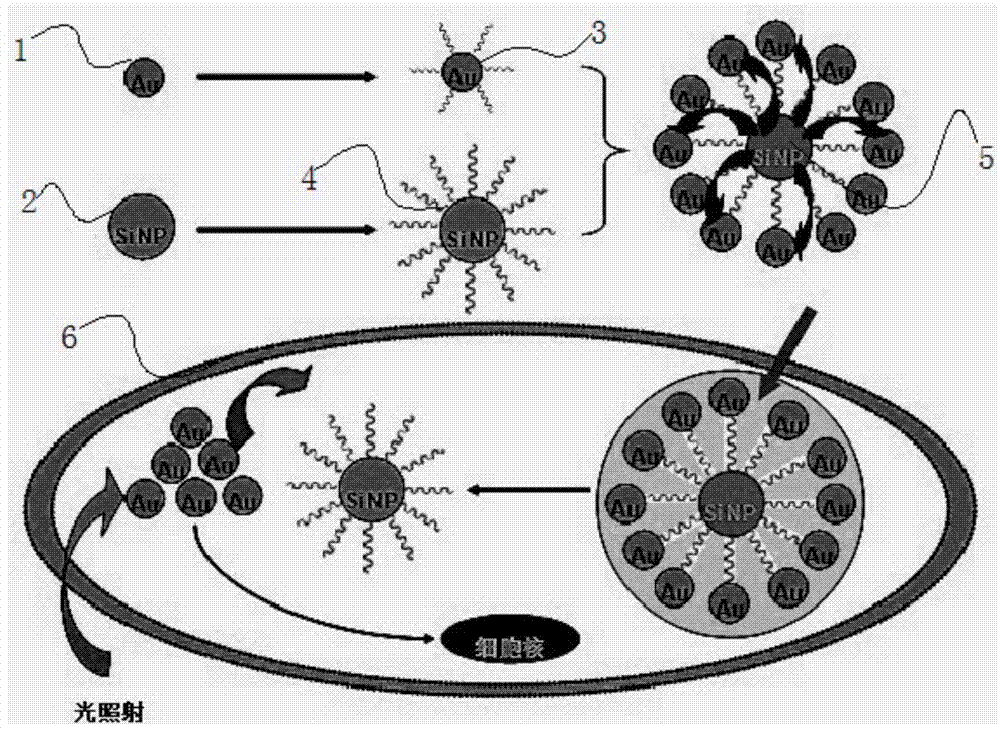Nano composite for targeted medicine delivery and treatment response monitoring as well as preparation method and application of nano composite
A nanocomposite and therapeutically responsive technology, applied in the fields of biomedicine and nanomedicine, can solve problems such as poor stability, easy expansion, and restrictions on the application of inorganic multifunctional nanomaterials, and achieve easy control of size and shape and high sensitivity Effect
- Summary
- Abstract
- Description
- Claims
- Application Information
AI Technical Summary
Problems solved by technology
Method used
Image
Examples
Embodiment 1
[0043] Nanocomplexes for targeted drug delivery and monitoring of therapeutic response were prepared by the following steps:
[0044] Step 1: Preparation of silica fluorescent nanoparticles with a diameter of 60 nm: Add 7.5 mL cyclohexane, 1.77 mL TX-100, 1.8 mL n-hexanol and 340 μL redistilled water into a 50 mL round bottom flask. After uniform stirring for 20 minutes, the reaction system formed a water-in-oil microemulsion system, and then slowly added 80 μL 0.1mol / L bipyridyl ruthenium hydrate and 100 μL tetramethoxysiloxane dropwise to the mixture, and after 30 minutes of reaction, added Siloxane was hydrolyzed with 60 μL of 28% ammonia. After reacting at room temperature for 24 hours, 50 μL of tetramethoxysiloxane and 50 μL of CTES (carboxyethylsilanetriol) were added, followed by further reaction at room temperature for 24 hours. After the reaction was completed, 20 mL of acetone was added to the reaction system to break the emulsion, followed by ultrasonication, vorte...
Embodiment 2
[0054] Another nanocomplex for targeted drug delivery and monitoring of therapeutic response was prepared by the following steps:
[0055] Step 1: Preparation of fluorescent silica nanoparticles with a diameter of 50 nm: Add 7.5 mL of cyclohexane, 1.77 mL of TX-100, 1.8 mL of n-hexanol and 340 μL of redistilled water into a 50 mL round bottom flask. After uniform stirring for 20 minutes, the reaction system formed a water-in-oil microemulsion system, and then slowly added 80 μL of 0.3 mg / L green fluorescent carbon dot aqueous solution (maximum emission wavelength 520 nm) and 100 μL of tetramethoxysiloxane to the mixture After reacting for 30 minutes, 60 μL of 28% ammonia water was added to hydrolyze the siloxane. After reacting at room temperature for 24 h, 30 μL of tetramethoxysiloxane and 30 μL of CTES (carboxyethylsilanetriol) were added, followed by further reaction at room temperature for 18 h. After the reaction was completed, 20 mL of acetone was added to the reaction ...
Embodiment 3
[0062] Another nanocomplex for targeted drug delivery and monitoring of therapeutic response was prepared by the following steps:
[0063] Step 1: Preparation of silica fluorescent nanoparticles with a diameter of 80 nm: Add 7.5 mL of cyclohexane, 1.77 mL of TX-100, 1.8 mL of n-hexanol and 340 μL of redistilled water into a 50 mL round bottom flask. After uniform stirring for 20min, the reaction system formed a water-in-oil microemulsion system, and then slowly added 80 μL 0.3mg / L iridium complex ([Ir(bzq) 2 [bpy(OH) 2 ]]Cl maximum emission wavelength 530nm) and 100 μL tetramethoxysiloxane, reacted for 30 minutes, then added 60 μL 28% ammonia water to hydrolyze the siloxane. After reacting at room temperature for 24 h, 100 μL of tetramethoxysiloxane and 100 μL of CTES (carboxyethylsilanetriol) were added, followed by further reaction at room temperature for 30 h. After the reaction was completed, 20 mL of acetone was added to the reaction system to break the emulsion, follow...
PUM
| Property | Measurement | Unit |
|---|---|---|
| particle diameter | aaaaa | aaaaa |
| particle diameter | aaaaa | aaaaa |
| diameter | aaaaa | aaaaa |
Abstract
Description
Claims
Application Information
 Login to View More
Login to View More - R&D Engineer
- R&D Manager
- IP Professional
- Industry Leading Data Capabilities
- Powerful AI technology
- Patent DNA Extraction
Browse by: Latest US Patents, China's latest patents, Technical Efficacy Thesaurus, Application Domain, Technology Topic, Popular Technical Reports.
© 2024 PatSnap. All rights reserved.Legal|Privacy policy|Modern Slavery Act Transparency Statement|Sitemap|About US| Contact US: help@patsnap.com









